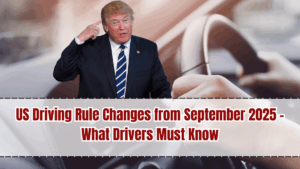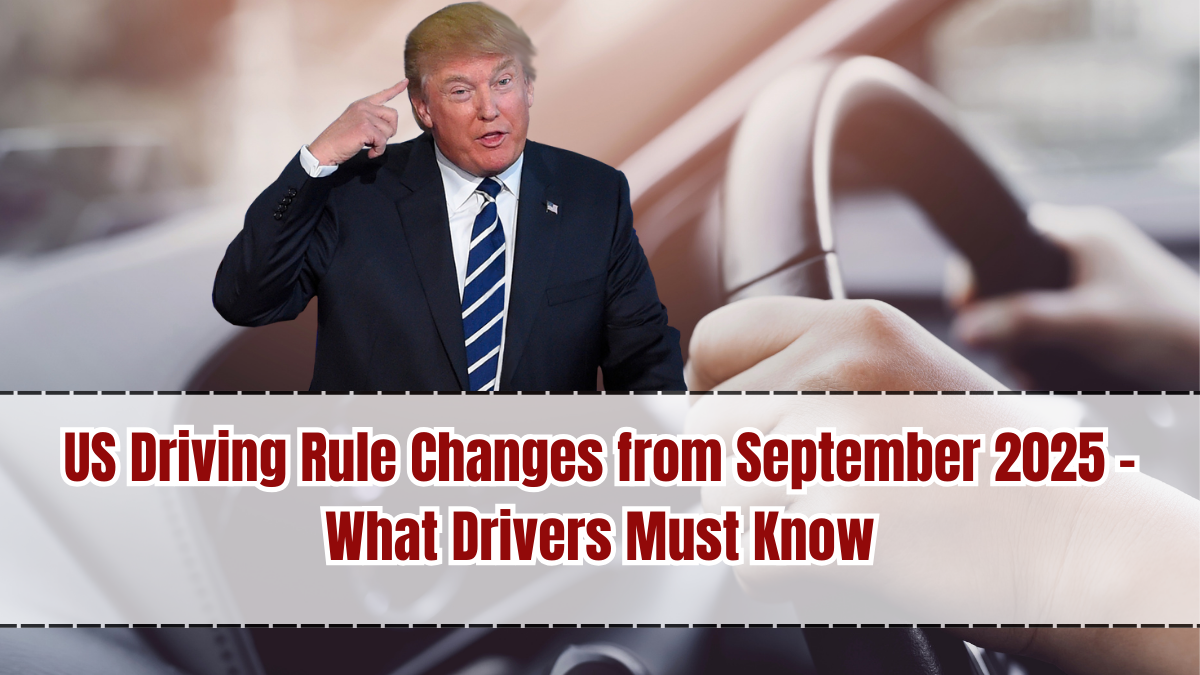Starting September 2025, drivers across the United States will face new driving rules as part of a nationwide update to traffic regulations and vehicle laws. These changes, introduced by the Department of Transportation (DOT) and enforced by state Departments of Motor Vehicles (DMVs), aim to enhance road safety, reduce traffic accidents, and modernize compliance in line with emerging technologies.
Motorists, commercial drivers, and even new learners must stay informed, as the new rules bring stricter penalties and mandatory safety requirements. Here’s a complete breakdown of what you need to know.

Why the US Introduced New Driving Rules
The changes were prompted by ongoing road safety concerns and the evolving nature of driving in the U.S.:
-
Distracted driving remains a leading cause of accidents.
-
Impaired driving, particularly involving cannabis and prescription drugs, has increased.
-
Rising pedestrian and cyclist fatalities in urban centers.
-
The growing use of electric and autonomous vehicles, requiring updated regulations.
The September 2025 reforms are intended to address these issues while aligning U.S. driving standards with global best practices.
Key Rule Changes Effective September 2025
1. Stricter Distracted Driving Penalties
-
Nationwide fines starting at $500 for first offences, up to $2,500 for repeat offences.
-
Drivers caught texting or holding a phone will also face 3–5 demerit points.
-
Hands-free use is permitted, but drivers must use mounted or integrated systems only.
2. Uniform Impaired Driving Standards
-
Cannabis impairment limits standardized across all states, aligning with alcohol regulations.
-
Mandatory roadside saliva and breath testing for suspected impairment.
-
License suspension periods increased for first-time offenders.
3. Speeding and Reckless Driving Reforms
-
New graduated fines based on how far drivers exceed the limit.
-
Over 30 mph above limit = automatic license suspension and potential court appearance.
-
In school zones and pedestrian-heavy areas, penalties are doubled.
4. Electric Vehicle (EV) and Autonomous Vehicle Regulations
-
EVs must comply with new sound alert systems to warn pedestrians.
-
Autonomous vehicles must pass updated federal safety inspections before deployment.
-
States required to establish emergency override protocols for self-driving cars.
5. New Protections for Pedestrians and Cyclists
-
Mandatory 3-foot passing distance for cyclists nationwide.
-
Heavier penalties for failing to yield to pedestrians at crosswalks.
-
New urban zones may include pedestrian-first traffic signals.
How These Rules Affect Drivers
For everyday motorists:
-
Using phones while driving will now carry harsher fines across all states.
-
Cannabis-impaired driving will be treated with the same seriousness as alcohol.
-
Drivers in urban areas must be more cautious around cyclists and pedestrians.
-
EV owners will face new compliance checks for sound alerts and safety features.
For commercial drivers:
-
Stricter testing for drug and alcohol impairment.
-
Increased penalties for reckless driving involving cargo trucks and buses.
Benefits of the New Law
-
Expected reduction in road accidents and fatalities.
-
Improved protection for vulnerable road users like pedestrians and cyclists.
-
Safer integration of autonomous and electric vehicles.
-
Stronger deterrents against distracted and impaired driving.
Criticisms and Concerns
While welcomed overall, some concerns remain:
-
Enforcement challenges for local police, especially in rural states.
-
Cost implications for EV owners and self-driving car manufacturers.
-
Drivers worry about increased insurance premiums tied to new penalties.
-
Civil liberty groups question expanded roadside testing for cannabis impairment.
Nonetheless, government agencies stress that the reforms prioritize safety and align with long-term transportation goals.
Preparing for September 2025
Drivers can prepare by:
-
Reviewing state DMV updates for localized enforcement details.
-
Installing hands-free phone mounts to comply with distracted driving laws.
-
Checking EVs for compliance with new sound alert requirements.
-
Taking refresher driving courses, especially for commercial drivers.
Conclusion
The US driving rule changes from September 2025 mark a major shift in traffic law enforcement. With tougher penalties for distracted and impaired driving, stronger protections for cyclists and pedestrians, and new compliance rules for electric and autonomous vehicles, the reforms are designed to make American roads safer and more efficient.
For drivers, the key is to adapt quickly and ensure full compliance. While some may view the changes as strict, the long-term benefits of fewer accidents and safer communities outweigh the inconveniences.
FAQs
What are the major driving law changes in September 2025?
Stricter distracted driving fines, new impaired driving rules, EV sound requirements, and protections for pedestrians/cyclists.
How much is the fine for texting while driving under the new law?
At least $500 for first offences, rising to $2,500 for repeat offenders.
Will cannabis-impaired driving be treated like alcohol?
Yes, uniform national standards will apply for cannabis impairment checks.
Are there new rules for cyclists and pedestrians?
Yes, drivers must keep a 3-foot distance when passing cyclists and yield at crosswalks or face higher fines.
Do EV and self-driving cars have new requirements?
Yes, EVs must include pedestrian warning sounds, and autonomous cars need federal safety approval.
Click here to know more.
